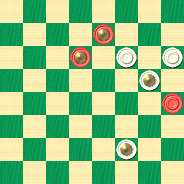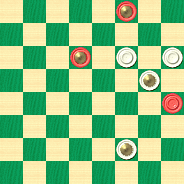The Checker Maven
Jump to navigationThe Noble Vine

The noble vine and its delicious fruits! The sweet, ripe grapes are in their own right a delightful treat; and the wine that might be made from them can reach loftly heights of pleasure for the palate.
But don't indulge quite yet, for after all, we have our monthly Checker School session to attend first. It, too, is a product of the noble vine; or more precisely, turn of the century checkerists T. Noble and R. Vine. Today they bring us a pair of positions that look similar but in fact are as different as white wine and red wine.
| T. NOBLE | R. VINE |
| WHITE | WHITE |
 |  |
| BLACK | BLACK |
| Black to Play and Draw | White to Play and Win |
| B:W22,21,K17,K6:BK26,K23,13. | W:W22,21,K17,K6:BK30,K23,13. |
Black is a man down in both positions, yet he seems to have an advantage in mobility in both cases also. What's the difference? How can he manage to pull out a draw in the first one, but not in the second?
That's what's standing between you and (at least possibly) some sophisticated refreshments at the moment. Solve the problems, and then click on Read More to check the fruits of your labor against the published solutions. You'll also see two sample games, complete explanatory notes, and a very interesting "Advice for Beginners" article from a news column of yesteryear.![]()
Solution
Solution and lettered notes are from Ben Boland's Famous Positions in the Game of Checkers. Numbered notes are by the editor, using the Kingsrow checker engine.
Black Plays: 23-19, 6-10, 19-23---A, 10-14, 23-27, 14-18, 27-24, 18-15, 24-27 15-19 27-32* (27-23, 19-24, White Wins), 19-15, 32-27, 15-10, 27-23. Drawn---1.
White Plays: 17-14, 30-25, 22-18, 25-22---2, 21-17, 22-15, 14-10. White Wins.
Game: 11-15, 22-18, 15-22, 25-18, 8-11, 29-25, 10-15, 25-22, 4-8, 23-19, 7-10---B, 27-23---C, 9-14, 18-9, 5-14, 24-20, 15-24, 28-19, 11-15, 32-28, 15-24, 28-19, 8-11, 22-18, 1-5, 18-9, 5-14, 19-16, 12-19, 23-7, 2-11, 26-23, 10-15, 31-27---D, 3-8, 30-26, 15-18, 23-19, 8-12, 19-15, 12-16, 15-8, 16-19, 8-3, 6-9, 27-23, 18-27, 26-22, 27-31, 3-7, 9-13, 7-10, 31-26, 10-17, 19-24, 20-16, 24-27, 16-11, 27-31, 11-7, 31-27, 7-2, 27-23, 2-6--E. Forms above position. Black to Play and Draw. T. Noble vs. P. Thirkell, Draughts World, Aug. 1902, Page 1346.
Game: 11-16, 24-19, 16-20, 22-18, 10-14, 26-22, 8-11, 30-26, 4-8, 28-24, 7-10, 22-17, 9-13, 18-9, 13-22, 25-18, 5-14, 18-9, 6-13, 32-28, 11-15, 29-25, 1-6, 25-22, 8-11, 19-16, 12-19, 23-7, 2-11, 24-19, 15-24, 28-19, 11-15, 19-16, 15-18, 22-15, 10-19, 26-23, 19-26, 31-22, 3-8, 16-12, 8-11, 12-8, 11-16, 8-3, 16-19, 3-7, 19-24, 27-23, 24-27, 7-2, 6-9, 2-6, 27-31, 6-10, 20-24, 23-18, 31-27, 18-15, 27-23, 15-11, 24-27, 11-7, 27-31, 7-2, 9-14, 10-17, 31-26, 2-6, 26-30---F. Forms above position. White to Play and Win. G. O'Connor vs. S. Levy, Glasgow Weekly Herald, and Game 3715 in the Melbourne Weekly Times.
A---19-24, 17-14,26-17, 14-18. White Wins.
B---9-13 and also 12-16 are quite drawable.
C---19-16, 12-19, 27-23, and Black is chasing the draw. H. Egan.
D---J. Steele vs. H. M. Smith at Springfield, U. S. A., Game 1404 Draughts World, July 1902 played 30-26, 6-9, 26-22, 9-13, 31-27, 3-8, 21-17, 14-21 and Steele won. A note suggests that 31-27 might draw. In the D. W. for Aug. 1902, the late Peter Thirkell pointed out that the game via 31-27 had been played between him and T. Noble.
E---G. O'Connor vs. S. Levy in the 1936 British Championship Games, continued with 26-30 and lost as in the above position.
F---Mr. Levy here suggested a draw, which was accepted; but 26-30 loses (as above); as pointed out by A. Fyfe. O'Connor then showed the draw by keeping the King on 26, then the 23-27 see-saw. See above play.
1---Right back where we started from, just about! The key to Black's draw lies in maintaining the "vise" with the king on 26 and the man on 13, holding the White king on 17 and the man on 22. In the second example, the Black king is on 30 instead of 26, and that makes all the difference.
2---23-19 avoids the shot but White then simply grinds out the 4x3 ending to a win.
The above position by R. Vine may be found as No. 330, Draughts World, Sept. 1895. King on 6 is a man, but the play is the same. Kear's Encyclopedia give it with "Author Unknown."
The writer came across the above position thus: Ben Boland, No. 125 the New Checkergram, June 1934. Black---5, 11, 12, 25, and White---13, 14, 19, 20. White to Play and Draw: 13-9, 25-30, 9-6*, 30-26, 6-2, 26-23, 2-7, 23-16, 14-10, 5-9, 10-6, 9-14, 6-1, 14-18, 1-6, 18-23, 6-10, 23-27, 10-14, etc. Drawn as above. If 7-3 instead of the last move 10-14, Black Wins as above, by R. Vine with a man on 27 instead of a King.
The winning idea however goes back to No..70 "Sturges' Critical Situations," 1808. Black---12, Kings 9, 18, 19, and White---15, 20, Kings 3, 11. White to Win by 20-16, 19-10, 11-7.
ADVICE FOR BEGINNERS
By HUGH EGAN
(In Melbourne Weekly Times)
"At the beginning of a game, it is better to play your pieces towards the centre of the board in the form of a pyramid, than to play into the side square, because a piece at the side can move only in one direction, and consequently loses half its power."
This seems logical, no doubt, and the, "pyramid idea" is regarded as gospel by the compilers of some handbooks on indoor games in which draughts receives somewhat indifferent--- in fact, harmful--- treatment.
Architecture in draughts, however, fails to stimulate the practical player's imagination. Certainly he finds some strength and beauty in exposed rows, and more particularly in diagonal lines; but he has no taste for "pyramid building."
When confronted with play of this kind, he at once sets to work to lay his hidden "mine" in an effort to shatter the structure to his own advantage. It is with the "pyramid builder" that the expert player has vast opportunities for those "pyrotechnical displays," those shots and strokes, which so astonish the newcomer.
"Don't play to the side" has no force with the expert exponent of the game. The power of the point that "A piece at the side can move only in one direction," is not felt by him simply because he is unable to ignore that other more vital fact, that the piece at the side is not exposed, and consequently loses all danger of capture whilst "marking time" as a side issue.
No. Present-day experts (nor past never had for that matter) have no faith in this ancient axiom. They play what they think is the best move under the circumstances, whether it be to the side, to the middle, or even the sacrifice of a piece or two--- at which latter phase of the game they are, of course, quite adept--- and the new-comer would do well to follow their example.
The novice should, however, examine each position carefully, and move always with an object in view, even if it is only an immediate threat, of giving "1 for 2," or "2 for 3."
11-15, regarded by players as the best starting point of a game, received the most attention from 19th century authors. Many players developed into "two game" players, playing 11-15 with Black, and always adhering to one particular opening with White--- such as the "Single-Corner" 22-18 in reply to 11-15; or "Ayrshire Lassie," 24-20 in reply to 11-15.
This naturally led to some method for broadening the scope of play, and the "two-move restriction" was brought into force in 1901. "Broadened by restriction" is not here a contradiction, as each player is forced to choose a starting move by ballot.
There are seven first moves for the Black pieces, with seven replies for White--- making 49 openings in all, with the opening moves decided by the two-move ballot.
Actually, 43 openings, were used, however, because 9-14, 21-17 and 10-14, 21-17, were rejected entirely; while 9-14, 23-18 and 10-14, 23-18, became known as "barred" openings, and were not in general use.
This made the two-move restriction as used for 35 years in British and American tournaments.
The two-move restriction is likely to be supplanted for modern play by the United States three-move restriction, which makes 137 openings; bringing 9-14, 23-18, and 10-14, 23-18, again into active use.

You can email the Webmaster with comments on this article.
